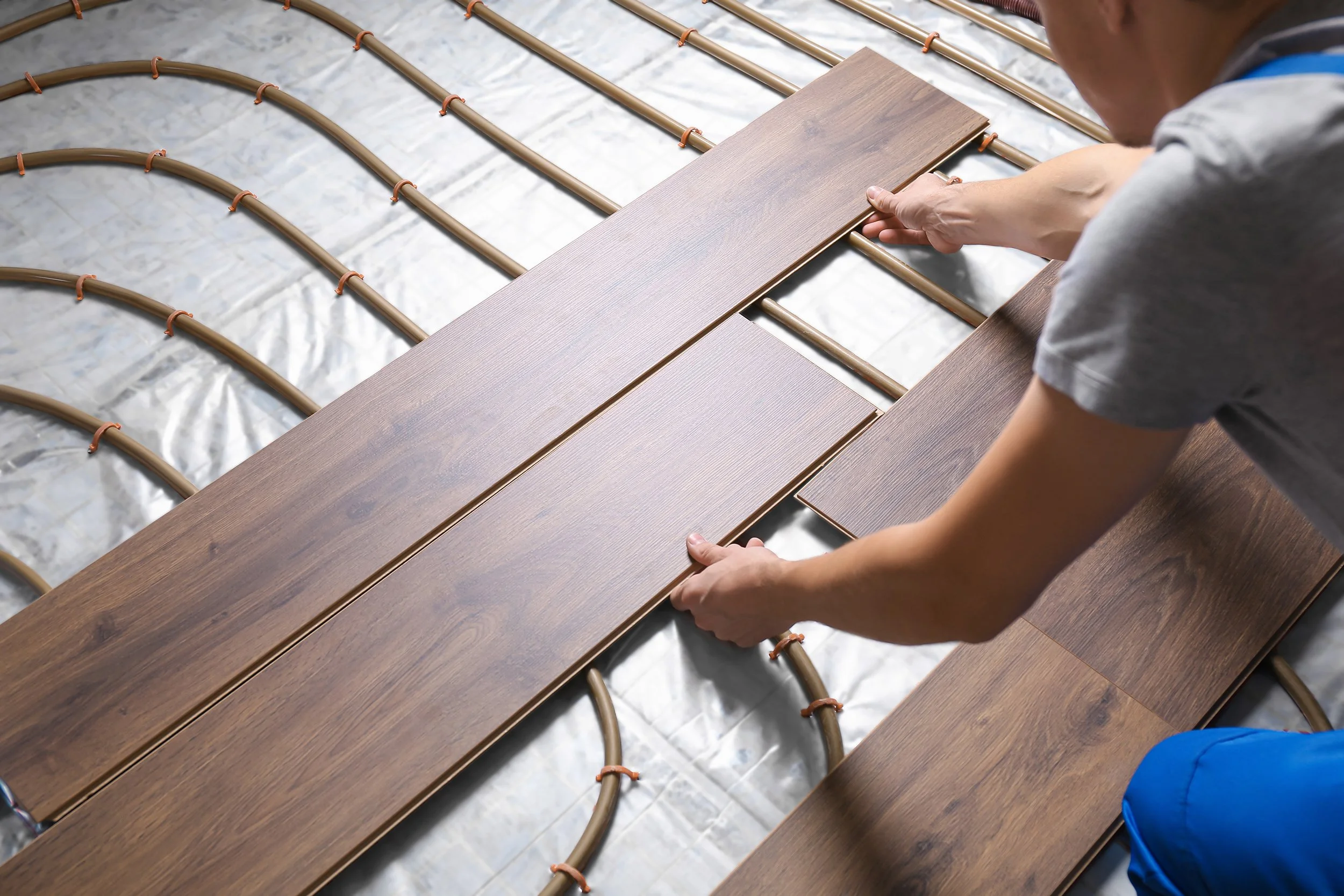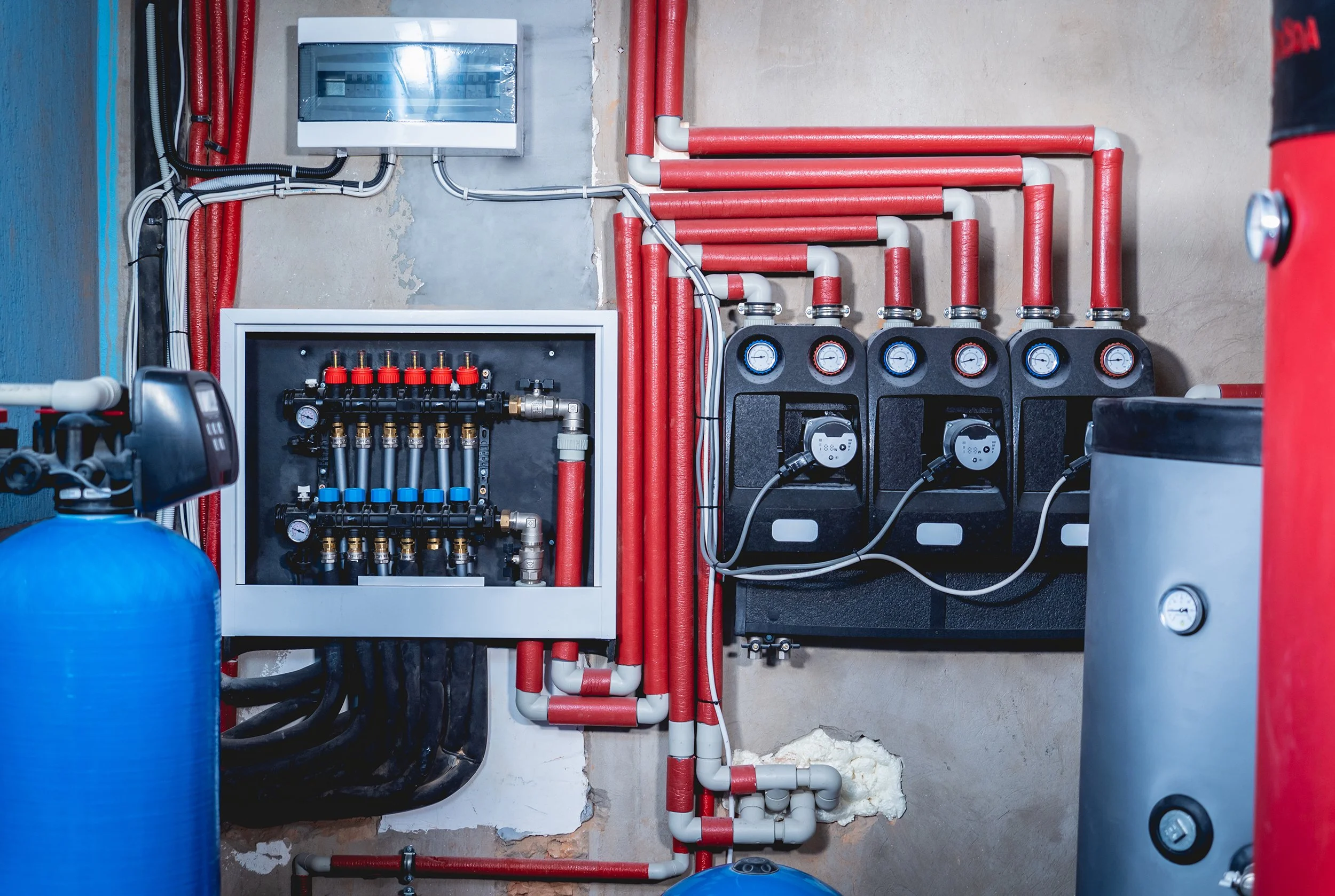Radiant Floor Heating Cost: Installation, Operation, and Maintenance Breakdown

Ever stepped onto a bathroom tile on a January morning and wondered if your feet might actually shatter from the cold? Well, imagine if your floors could give you a warm, welcoming hug instead of that rude arctic awakening.
Welcome to the luxurious world of radiant floor heating, where every step feels like walking on sunshine and your toes never have to stage a rebellion against winter mornings again. But before you start fantasizing about toasty floors and jealous houseguests, let's talk numbers. Because while radiant heating promises to transform your home into a cozy paradise, it also comes with a price tag that deserves some serious consideration.
From installation costs that can make your wallet wince to long-term savings that might make you smile, radiant floor heating is an investment that requires both financial planning and realistic expectations. Let's break down every dollar and cent, so you can decide if this flooring fairy tale is worth writing your own happy ending.
Understanding Radiant Floor Heating Systems
Radiant floor heating transforms your floors into giant, gentle radiators that warm your space from the ground up. Unlike traditional forced-air systems that blow hot air around (and inevitably leave cold spots in corners), radiant heating provides consistent, even warmth that rises naturally through your living space.
There are two primary types of radiant floor heating systems, each with distinct cost implications. Electric radiant heating uses a network of electric cables or heating mats installed beneath your flooring. These systems are typically easier and less expensive to install, making them popular for bathroom renovations and smaller spaces. However, they generally cost more to operate due to electricity prices.
Hydronic radiant heating circulates heated water through a network of flexible tubing installed in your subfloor or embedded in concrete slabs. These systems require a boiler or water heater to heat the water, plus pumps and controls to circulate it effectively. While hydronic systems involve higher upfront installation costs, they typically offer lower operating expenses and greater efficiency for larger areas.
Within hydronic systems, there's an important distinction between open and closed systems that significantly affects costs. Closed systems use a dedicated boiler or water heater exclusively for radiant heating, with the heating fluid completely separate from your domestic hot water supply. This separation adds equipment costs but provides several advantages: easier code compliance, ability to use antifreeze in harsh climates, and system redundancy (if your radiant heat fails, you still have domestic hot water).
Open systems, conversely, integrate radiant heating with domestic water heating using a single water heater, reducing equipment costs but requiring more complex controls and limiting fluid options. The choice between these approaches can affect your installation costs by $2,000 to $5,000, with closed systems typically being more expensive due to requiring separate water heating equipment.
The choice between electric and hydronic systems (and within hydronic, open versus closed) significantly impacts both your initial investment and long-term operating costs. Electric systems work well for supplemental heating in specific rooms, while hydronic systems excel at whole-house heating applications.
Installation Costs: The Initial Investment
Installation costs for radiant floor heating vary dramatically based on system type, square footage, existing infrastructure, and regional labor rates. Understanding these variables helps you budget realistically and avoid sticker shock when contractors present their estimates.
Electric Radiant Heating Installation
Electric systems typically cost between $8 to $15 per square foot for materials and installation. A standard bathroom renovation (approximately 50 square feet) might cost $400 to $750, while a larger kitchen project (200 square feet) could range from $1,600 to $3,000.
Material costs for electric systems include heating cables or mats ($3 to $8 per square foot), thermostats ($100 to $300), and installation supplies. Professional installation adds $3 to $7 per square foot, depending on complexity and local labor rates.
Electric systems are generally easier to retrofit into existing homes, as they don't require extensive plumbing modifications. However, electrical upgrades may be necessary if your home's electrical panel lacks sufficient capacity for the additional load.
Hydronic Radiant Heating Installation
Hydronic systems represent a more substantial investment, typically costing $10 to $20 per square foot for installation, not including the heating source. A whole-house system for a 2,000 square foot home could range from $20,000 to $40,000, including boiler, pumps, controls, and professional installation.
The tubing itself costs $2 to $4 per square foot, but installation complexity drives up labor costs significantly. Hydronic installations often require concrete slab work, extensive plumbing, and coordination between multiple trades, increasing both time and expense.
New construction offers the most cost-effective opportunity for hydronic radiant heating, as tubing can be installed during the initial building phase. Retrofitting existing homes often requires removing flooring and sometimes subfloors, substantially increasing costs.
Additional Installation Considerations
Flooring compatibility affects installation costs and complexity. Tile and stone floors work excellently with radiant heating and don't require special considerations. Hardwood floors may need specific installation techniques or moisture barriers, adding to costs. Carpet requires careful pad selection and may reduce system efficiency.
Insulation improvements often accompany radiant heating installations, particularly in retrofits. Proper insulation beneath the heating system prevents heat loss and improves efficiency, but adds $2 to $4 per square foot to project costs.
Permits and inspections vary by location but typically cost $200 to $500 for residential installations. Some areas require specific certifications for radiant heating installers, which may limit contractor options and affect pricing.
Operating Costs: Monthly Expenses and Energy Efficiency
Understanding operating costs helps you evaluate the long-term financial impact of radiant floor heating. These costs depend on system type, local utility rates, home insulation, climate conditions, and usage patterns.
Electric System Operating Costs
Electric radiant heating operating costs vary significantly based on electricity rates, which range from $0.08 to $0.30 per kilowatt-hour across different regions. A typical bathroom system using 200 watts might cost $15 to $60 monthly when operated 8 hours daily.
Electric systems offer precise zone control, allowing you to heat only occupied spaces. This targeted heating can reduce overall energy consumption compared to heating entire homes, potentially offsetting higher electricity costs.
However, electric resistance heating is inherently less efficient than heat pumps or gas heating. In areas with expensive electricity, operating costs can become substantial, particularly for larger installations or whole-house applications.
Hydronic System Operating Costs
Hydronic systems typically offer lower operating costs, especially when connected to efficient boilers or water heaters. Natural gas boilers often provide the most economical operation, with costs ranging from $0.50 to $1.50 per therm.
A well-designed hydronic system for a 2,000 square foot home might cost $600 to $1,200 annually to operate, depending on climate and usage patterns. Systems connected to high-efficiency condensing boilers or heat pumps can achieve even lower operating costs.
Hydronic systems can integrate with alternative energy sources, including solar thermal collectors, geothermal heat pumps, or wood-fired boilers. These integrations can significantly reduce operating costs while improving environmental sustainability.
Efficiency Factors and Energy Savings
Radiant heating systems operate at lower temperatures than traditional heating methods, typically requiring water temperatures of 85°F to 140°F compared to 180°F for traditional radiators. This lower operating temperature improves boiler efficiency and reduces heat loss.
The even heat distribution of radiant systems often allows occupants to feel comfortable at lower thermostat settings. Reducing your thermostat by 2°F to 3°F can decrease heating costs by 10% to 15% while maintaining comfort levels.
Programmable thermostats and zoning controls optimize efficiency by heating spaces only when needed. Advanced controls can learn occupancy patterns and pre-heat floors before you wake up or return home, maximizing comfort while minimizing energy waste.
Maintenance Requirements and Long-Term Costs
Radiant floor heating systems generally require minimal maintenance compared to forced-air systems, but understanding maintenance requirements helps you budget for long-term ownership costs.
Electric System Maintenance
Electric radiant heating systems have few moving parts, resulting in minimal maintenance requirements. The heating cables or mats typically carry warranties of 10 to 25 years and rarely require attention once properly installed.
Thermostat maintenance involves occasional battery replacement and calibration checks. High-quality programmable thermostats should provide years of reliable service with minimal intervention.
The primary concern with electric systems is cable damage during flooring renovations or repairs. Accidentally nailing or drilling through heating cables requires professional repair, potentially costing $200 to $500 per incident.
Hydronic System Maintenance
Hydronic systems require more comprehensive maintenance due to their complexity. Annual boiler servicing costs $150 to $300 and should include combustion analysis, heat exchanger cleaning, and safety system testing.
Pump maintenance involves checking for leaks, monitoring performance, and occasionally replacing seals or impellers. Circulation pumps typically last 10 to 15 years with proper maintenance.
System flushing removes accumulated sediment and air bubbles that can reduce efficiency. Professional flushing every 3 to 5 years costs $200 to $400 but helps maintain optimal performance.
Water quality affects hydronic system longevity. Areas with hard water may require water treatment systems costing $500 to $1,500 to prevent scale buildup and corrosion.
Component Replacement and Upgrades
Thermostats and controls typically require replacement every 10 to 15 years as technology advances and components wear out. Budget $200 to $500 for thermostat upgrades.
Boiler replacement represents the largest long-term expense for hydronic systems. High-quality boilers last 15 to 25 years, with replacement costs ranging from $3,000 to $8,000 including installation.
Electric system components rarely require replacement except in cases of damage or electrical upgrades. However, outdated thermostats may benefit from smart thermostat upgrades costing $200 to $400.
Cost Comparison with Traditional Heating Systems
Comparing radiant floor heating costs with traditional systems helps you evaluate the financial implications of different heating choices.
Installation Cost Comparisons
Traditional forced-air systems typically cost $3,000 to $7,000 for whole-house installations, significantly less than hydronic radiant systems but comparable to electric radiant heating for smaller areas.
Heat pump installations range from $4,000 to $12,000, falling between radiant heating options. However, heat pumps provide both heating and cooling, potentially eliminating separate air conditioning costs.
Baseboard heating installations cost $400 to $1,200 per room, making them competitive with electric radiant heating for individual room applications.
Operating Cost Analysis
Radiant heating systems often provide 15% to 30% lower operating costs compared to forced-air systems due to improved efficiency and comfort at lower temperatures. However, actual savings depend on system design, installation quality, and usage patterns.
Heat pumps typically offer the lowest operating costs in moderate climates, while radiant heating excels in consistently cold climates where heat pumps lose efficiency.
Comfort and Value Considerations
While not directly quantifiable, radiant heating provides superior comfort compared to other heating methods. The elimination of cold spots, drafts, and noise adds value that many homeowners find worth the additional investment.
Radiant heating systems can increase home resale value, particularly in luxury markets. While exact returns vary, many real estate professionals consider radiant heating a premium feature that attracts buyers.
Financial Planning and Return on Investment
Understanding the financial aspects of radiant floor heating helps you make informed decisions and plan for both immediate and long-term costs.
Financing Options
Many contractors offer financing plans for radiant heating installations, allowing you to spread costs over several years. Interest rates vary, but promotional periods with 0% financing are common.
Home equity loans or lines of credit often provide lower interest rates for major home improvements. These options allow you to take advantage of tax benefits while investing in your home's comfort and value.
Some utility companies offer rebates or incentives for high-efficiency heating systems, including radiant floor heating. Research local programs that might offset installation costs.
Payback Period Analysis
Electric radiant heating systems typically pay for themselves through comfort improvements rather than energy savings. The convenience and luxury often justify the investment for many homeowners.
Hydronic systems may achieve payback through energy savings in 8 to 15 years, depending on operating cost differences and system efficiency. Homes with high heating costs or inefficient existing systems see faster payback periods.
Long-Term Value Proposition
Radiant heating systems often last 25 to 50 years with proper maintenance, providing decades of comfortable heating. This longevity spreads the initial investment over many years of service.
The improved comfort, energy efficiency, and potential home value increases make radiant heating an investment in both daily living quality and long-term property value.
How a Home Concierge Service Simplifies Radiant Floor Heating
Managing radiant floor heating systems—from installation planning to ongoing maintenance—can be overwhelming for busy homeowners. This is where a luxury home concierge service becomes invaluable, acting as your dedicated advocate throughout the entire process.
Installation Project Management:
A home concierge service handles the complex coordination that radiant floor heating installation requires. They'll vet and manage multiple contractors (flooring specialists, plumbers, electricians), ensure proper sequencing of work phases, and monitor quality at each step. Rather than juggling multiple quotes and schedules yourself, your concierge becomes the single point of contact, ensuring the project stays on budget and timeline while you focus on your daily life.
Ongoing System Maintenance:
Radiant floor heating systems require specialized knowledge for optimal performance. Your home concierge coordinates annual system inspections, manages boiler maintenance for hydronic systems, monitors energy efficiency, and maintains warranty records. They'll also schedule seasonal system cycling, pressure testing, and fluid level checks—technical tasks that are easy to forget but critical for system longevity.
Emergency Response and Repairs:
When issues arise—whether it's uneven heating, strange noises, or complete system failure—a home concierge service provides immediate response. They maintain relationships with specialized radiant heating technicians, can quickly diagnose whether it's an emergency requiring immediate attention or routine maintenance, and handle all coordination while keeping you informed of progress and costs.
Long-Term System Optimization:
Beyond basic maintenance, a quality home concierge service tracks your system's performance over time, identifying opportunities for efficiency improvements or upgrades. They'll monitor energy usage patterns, coordinate smart thermostat installations, and ensure your system continues operating at peak performance as your home's needs evolve.
This level of comprehensive care transforms radiant floor heating from a complex home system requiring constant attention into a seamlessly managed luxury amenity that simply works.
Making the Decision: Is Radiant Heating Right for You?
Several factors determine whether radiant floor heating makes financial sense for your situation.
Ideal Candidates for Radiant Heating
Homeowners planning major renovations or new construction can install radiant heating most cost-effectively. The ability to integrate installation with other construction activities reduces labor costs and disruption.
People with allergies or respiratory sensitivities benefit from radiant heating's lack of air circulation, which doesn't distribute dust and allergens like forced-air systems.
Homes in consistently cold climates where heating systems operate for extended periods see the greatest benefit from radiant heating's efficiency advantages.
Situations Where Alternative Systems Make More Sense
Rental properties or homes where owners plan to move within a few years may not justify radiant heating's higher initial investment.
Homes with excellent existing heating systems and satisfied occupants might not see sufficient benefit to warrant the disruption and expense of radiant heating installation.
Very mild climates with minimal heating requirements don't provide enough operating hours to justify radiant heating's installation costs through energy savings.
Conclusion: Stepping Into Warmth
Radiant floor heating represents a significant investment that transforms your home's comfort while potentially reducing long-term energy costs. While installation costs can be substantial—ranging from hundreds of dollars for small electric systems to tens of thousands for whole-house hydronic installations—the combination of superior comfort, energy efficiency, and long-term durability often justifies the expense.
The key to making a smart radiant heating investment lies in careful planning, realistic cost analysis, and understanding your specific needs and circumstances. Consider your climate, existing heating costs, renovation plans, and long-term housing intentions when evaluating this comfort upgrade.
Remember that radiant floor heating is more than just a heating system—it's a daily luxury that eliminates cold floors forever. While the financial calculations matter, the pure joy of warm feet on winter mornings might be the most compelling argument of all. After all, can you really put a price on never doing the cold floor dance again?
Home Concierge for Luxury Home Property Management
At Willow, we take a proactive approach to home care, ensuring your luxury home remains in pristine condition year-round. From routine maintenance and seasonal upkeep to coordinating trusted vendors for repairs and upgrades, we handle it all with a high-touch, concierge-style experience tailored to your needs.
Let us take home management off your plate. Contact Willow today to learn how our services can help you protect, maintain, and enhance your home with ease.
Willow is a luxury home concierge service based in Boulder, Colorado. We care about your home and giving you back your time to do the things you care about most.
How it Works






